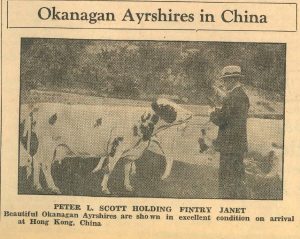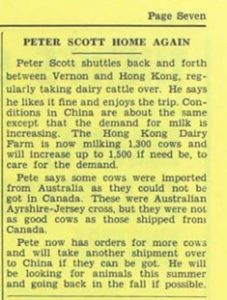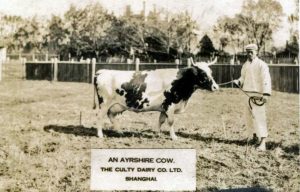Ayrshires exported to the Far East
In the early 1930s, Fintry began exporting Ayrshires to China. After more than ten years of difficulties and political changes, China began rebuilding its economy. Canada, recognizing this, began to promote the products that China needed to rebuild the nation and support her 400,000,000 people. Steel, lumber, copper and construction machinery was shipped to China. At the same time, other products were promoted that were relatively unfamiliar there but, with strong marketing, quickly became desired household items – flour, fruit and even dairy products.
Following suit, the Canadian Dairy industry began sending sales reps to China to introduce fresh milk to the local diet. Dairy farmers in B.C. and the Okanagan quickly followed.
Peter Lennox Scott became the Okanagan field man who arranged sales and traveled to China with the cattle. From his experience with the Fintry herd, Scott was well-informed about Ayrshires and very partial to the breed.
In December, 1931, Scott left with the first shipment of Okanagan Ayrshires. He and the cattle traveled by train to the Port of Vancouver, then boarded the Blue Funnel liner Tyndareus to Hong Kong. In 1931-1932, the crossing by steamship would have taken him about 18 days with a passenger fare of $375.
Scott and the first shipment of Okanagan dairy cattle arrived in Hong Kong for the Pok Fu Lam farm, owned by the Hong Kong Dairy and Cold Storage. Over the next decade, Peter Scott accompanied many shipments of Okanagan Ayrshires to China, to Hong Kong and in later years to Shanghai.
Milk and dairy products, although at first mainly consumed by expatriates, began to catch on. By 1941, the Pok Fu Lam farm held 1900 dairy cattle. Unfortunately, only 300 cattle remained at the end of World War II but, since then, China’s dairy industry has continued to grow.





